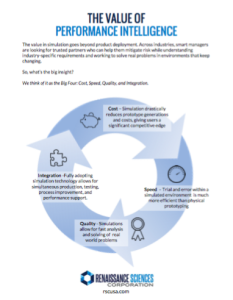From Data to Performance Intelligence

From Data to Performance Intelligence
Part One
The Opportunity
Leaders in all kinds of organizations are challenged with knowing how to effectively use data to their advantage. Rather than letting data overwhelm management, smart organizations collect, understand, and capitalize on data in ways that are timely, measurable, and delivered to take best advantage of emerging technologies. In industries spanning healthcare, aviation, entertainment, and manufacturing, buzzwords abound and terms like “information” or “insights” are used to capture the concept that data alone is useless unless it is available in some useful form; unless it creates something like “intelligence.”
That’s fine, but the value of intelligence drawn from data needs to be further defined and tied to an organization’s demonstrable (measurable) success. This can include higher quality, better productivity, reduced time to market, and a better bottom line. It should impact operations, engineering, production, and management.
Performance Intelligence
Performance Intelligence is a way of thinking about how data-driven insights can both support your people and, as an ongoing system of human improvement, generate additional insights – creating a cyclical system that learns along the way. Organizations that think of their employees as Performers invest in ways to support and improve performance by preparing humans in a classroom for the challenges they will face in the real world.
For many kinds of challenges, the dangers of inadequate preparation and support are life and death. An increasing number of organizations in manufacturing, healthcare, entertainment, aviation, and the military are charged with developing simulated training programs that impact high-risk activities like medical procedures, driving, flying, and combat. In these environments, an ounce of prevention is priceless.
The Business Requirement
Ask a Senior Engineer in today’s manufacturing industry about the pressure they feel to innovate more, reduce costs, and maintain quality – all at the same time. Manufacturing processes that cut costs cannot risk quality – driving the need to reduce both waste and error. Using simulation technology, manufacturing processes can be planned and tested before production begins, increasing uptime and decreasing error and waste. That same Senior Engineer will tell you that sleep is lost over downtime, poor cost management, and thinning profit margins. Simulation gives an advantage in the market, driven by savings that do not negatively impact quality.
But the business need is not simple and is changing as fast as technology changes. Today’s simulation environments vary in their sophistication and usefulness. In an age of video games and HD graphics, it is tempting to want simulated environments that look better than real life. Remember, your performers need to do well in the real world.
Leading simulation tools are also an investment in the business: simulated training and support is not cheap, but it saves money in the long term. And while cost savings can justify the investment, an even better payoff is in the ongoing performance support and performance improvement that simulation offers.
Application
In any airport, time is currency. Ongoing improvements in on-time delivery of service, without risking safety, are made possible by first collecting data from a variety of sources. What’s the weather like? Is this a holiday weekend? Is there a strike in a major city? Has there been an accident? Are there threats or acts of terrorism?
Making proper use of “big data” allows U.S. airlines to reduce the gap between flight arrival and departure times … creating a better experience for the public, a higher profit margin for the company, and a less stressful work environment for airline employees – all without risking quality, e.g., without risking lives.
In healthcare, innovation and experimentation have a built-in liability: the wealth and wellness of real people. How do you test new procedures without risking the safety of patients? Medical education that is simulation-based provides valuable tools for learning while removing ethical and practical problems that real-world practice brings. In terms of simulation-based training and testing, lessons learned in one industry can be applied to others.
A good example of this is the technology that drives night vision. Advances in night vision for the aviation industry drive advances in night readiness and night vision goggle technology – critical for military and defense applications. Night vision is used to train and support aircrew in defense, homeland security, and domestic aviation – offering realistic simulated situations that prepare learners well for challenges that they will face in the real world including trainings for novice and experienced professionals with job titles like medic, crash safety manager, and navy pilot.
Finally, complete adoption of simulation and sensor technologies calls for full integration into critical processes, not just a training program. Organizations applying simulation early and repeatedly end up changing their product development processes, working simulation processes into engineering processes.
So how does simulation technology help build Performance Intelligence? Beyond the value of simulating an environment for training and testing purposes, a system that can adapt and evolve based on user behavior (based on where errors commonly occur, for example) is a system that learns, changes and provides better support over time.
So What’s Next?




